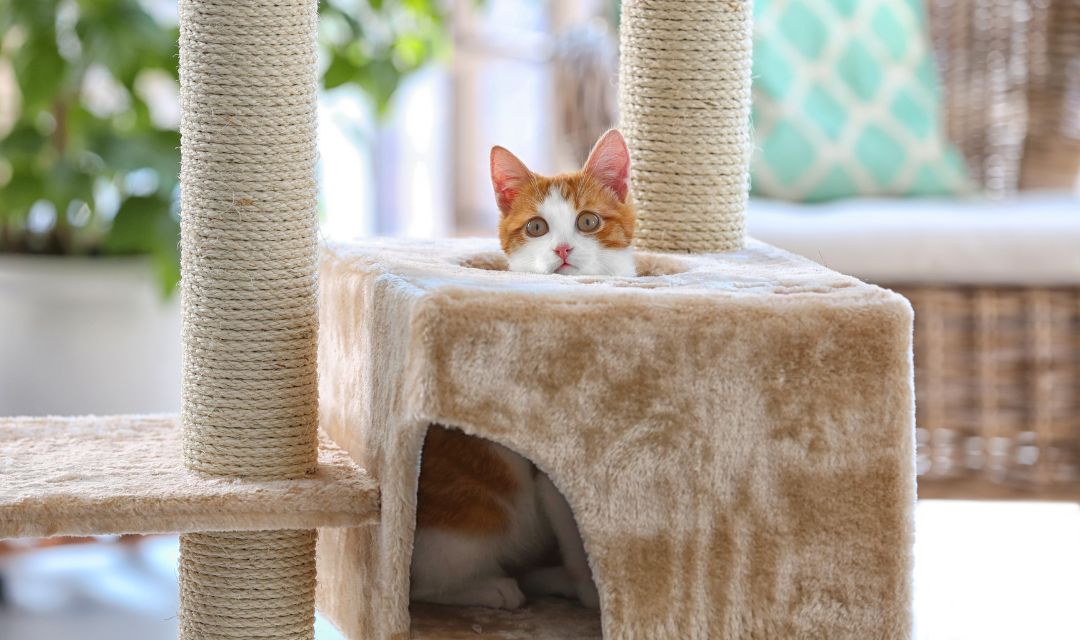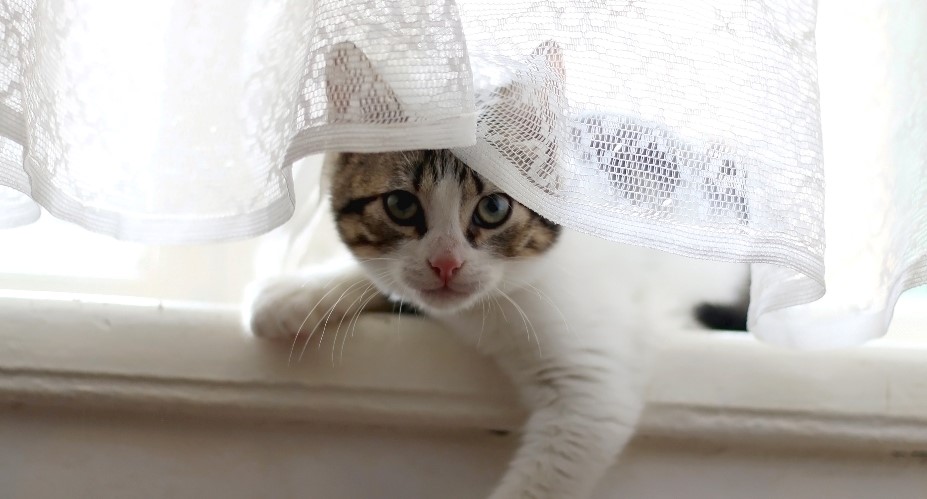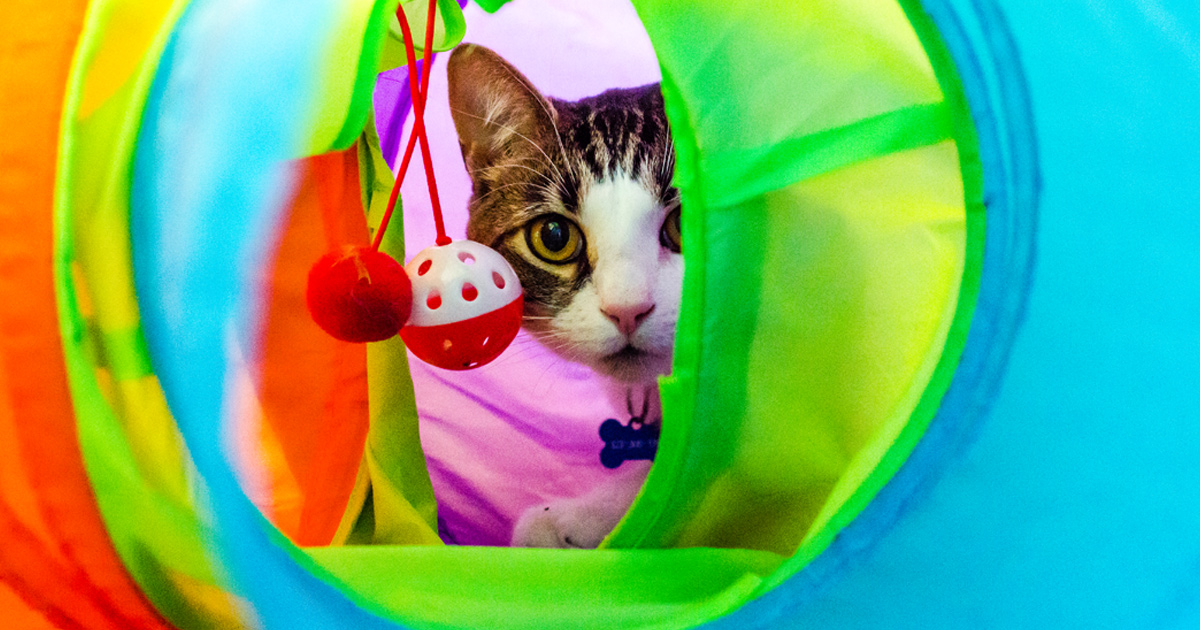Introduce your cat to baby scents
:max_bytes(150000):strip_icc()/intro-cat-to-baby-85140691-2000-68e4cbb05d3042b4b11aefab2c79bb4c.jpg)
Introducing your cat to baby scents is an essential step in preparing your furry friend for the arrival of a new human sibling. Cats have highly developed senses, and they rely heavily on their sense of smell to navigate and understand their environment. By gradually introducing your cat to the scents associated with a baby, you can help ease the transition and reduce any potential stress or anxiety.
Start by bringing items that carry the baby's scent into your home before the arrival of the baby. These items can include blankets, clothing, or even diapers. Make sure these items are clean and safe for your cat to explore. Place them in areas where your cat frequently spends time, such as their bed or a favorite resting spot.
Allowing your cat to investigate these scented items at their own pace will help them become familiar with the new smells associated with a baby. It is important not to force the interaction but rather let your cat approach these items voluntarily. Cats are naturally curious creatures, and they will likely show interest in exploring the new scents on their own terms.
To further associate positive experiences with baby scents, consider offering treats or special meals near these scented items. This positive reinforcement will create a positive association between the smells and something enjoyable for your cat.
Additionally, using synthetic pheromones can be helpful in calming stressed or anxious cats. Products such as Feliway mimic natural feline pheromones, promoting a sense of familiarity and comfort for your cat. Placing Feliway diffusers near areas where you want your cat to feel relaxed can be effective in reducing any potential signs of stress during the introduction process.
As you introduce baby scents to your cat, it is important to monitor their reaction closely. Some cats may exhibit signs of discomfort or anxiety, such as excessive grooming, hiding, or aggression. If you notice any concerning behaviors, consult with a veterinarian or a professional behaviorist for guidance on how to alleviate your cat's stress.
Remember, each cat is unique, and their response to new scents may vary. Some cats may be naturally more adaptable and accepting of change, while others may require more time and patience. It is crucial to respect your cat's boundaries and give them the space they need to adjust at their own pace.
By gradually introducing your cat to baby scents, you are allowing them to acclimate slowly and build positive associations. This will help create a smoother transition when the new baby arrives. Remember to remain patient and understanding throughout the process, as it may take time for your cat to fully adjust. Providing your cat with a safe and comfortable environment is essential for ensuring a harmonious relationship between your feline friend and their new human sibling.
Create safe spaces for your cat

Creating safe spaces for your cat is crucial when preparing for the arrival of a new human sibling. Cats are creatures of habit and value their personal space, so providing them with designated areas where they can feel secure will help alleviate any stress or anxiety they may experience during this transition.
One way to create a safe space for your cat is by setting up a cozy and comfortable hiding spot. This can be achieved by placing a soft blanket or bed in a quiet corner of your home where your cat can retreat to when they need some alone time. Ensure that the space is away from high-traffic areas and loud noises, as this will give your cat a sense of privacy and security.
In addition to a hiding spot, it's important to provide vertical spaces for your cat to escape to. Cats love to climb and perch on elevated surfaces, so consider installing cat trees, shelves, or window perches. These elevated spaces not only provide physical exercise for your cat but also allow them to observe their environment from a safe distance. It's essential to anchor these structures securely to prevent any accidents or injuries.
Another aspect of creating safe spaces is ensuring that there are enough resources available for each pet in the household. This includes providing separate food and water bowls, litter boxes, scratching posts, and toys for both your cat and the new baby. Cats are territorial animals, so having their own resources will help prevent any potential resource guarding behaviors or conflicts between them and the baby.
Furthermore, make sure that your cat has access to their essentials without interference from the baby. Consider installing baby gates or using tall barriers to create restricted areas where your cat's litter box, food, and water are located. This will allow your cat to have uninterrupted access to these necessities while keeping them separate from the baby's play area.
It's important to establish boundaries between your cat and the baby early on. Teach your child not to disturb the cat while they are in their safe spaces and to approach them gently and calmly when they want to interact. Supervision is key during interactions between your cat and the baby, especially in the beginning stages when they are still getting used to each other.
Finally, make sure that your cat's safe spaces remain off-limits to the baby. Set clear boundaries for the baby, such as not allowing them to enter or play in areas designated for the cat. This will help your cat feel secure and prevent any potential accidents or conflicts from arising.
In conclusion, creating safe spaces for your cat is vital when preparing for a new human sibling. These spaces provide comfort, security, and privacy for your furry friend during this transitional period. By setting up hiding spots, providing vertical spaces, ensuring separate resources, establishing boundaries, and keeping the baby out of your cat's safe spaces, you are promoting a harmonious environment where both your cat and baby can coexist peacefully. Remember, patience and understanding are key as it may take time for your cat to fully adjust to the presence of a new family member.
Gradually adjust your cat's routine

One important aspect of preparing your cat for the arrival of a new human sibling is gradually adjusting their routine. Cats are creatures of habit and thrive on a predictable schedule. Any sudden changes in their routine can cause stress and anxiety. To help ease this transition, it's crucial to slowly introduce and acclimate your cat to the changes that will occur once the baby arrives.
Start by making small adjustments to your cat's daily routine several weeks before the baby's arrival. This will give your cat time to adapt and associate these changes with positive experiences. For example, if you know that certain activities or noises associated with caring for a baby will be part of your cat's new routine, such as bottle feeding or using a baby monitor, you can begin incorporating those activities into your daily interactions with your cat.
Gradually introduce any new sounds or scents that will be present when the baby arrives. Play recordings of baby sounds at low volume to familiarize your cat with these noises. Gradually increase the volume over time while observing your cat's reactions. This gradual exposure will help desensitize your cat and prevent them from associating these sounds with fear or anxiety.
Introduce your cat to baby scents by bringing home items that have been in contact with the newborn, such as blankets or clothing. Allow your cat to sniff and explore these items under supervision. Reward positive behavior with treats or praise to create positive associations.
Changes in schedule can also impact your cat's routine. If you anticipate differences in feeding times or periods of increased activity due to caring for the baby, gradually adjust these aspects as well. Start by shifting mealtimes slightly earlier or later each day until they align closer to the desired schedule. Similarly, gradually expose your cat to increased activity levels by incorporating short play sessions throughout the day.
It's important not to neglect quality one-on-one time with your cat during this adjustment period. Set aside dedicated playtime or cuddling sessions to ensure that your cat continues to receive the attention and affection they need. This will help strengthen the bond between you and your cat and reinforce their sense of security.
In addition to adjusting your cat's routine, it's essential to maintain a consistent environment for them. Keep your cat's living space as familiar as possible by avoiding major changes in furniture arrangements or introducing new items during this time. Stability will provide a sense of comfort and security for your cat amidst the changes happening around them.
As you gradually adjust your cat's routine, pay attention to their behavior and body language. If you notice signs of stress, such as excessive grooming, decreased appetite, or hiding, take a step back and slow down the adjustment process. Every cat is unique, and some may require more time and patience than others.
Remember to be patient throughout this process. It may take time for your cat to fully adapt to the new routine, but with consistency and positive reinforcement, they will learn to associate these changes with positive experiences. By preparing your cat for the upcoming changes in their routine, you are setting them up for a smoother transition when the baby arrives.
Teach your child how to interact with the cat

Teaching your child how to interact with the cat is crucial for both their safety and the well-being of your furry friend. Cats have different boundaries and communication cues than humans, so it's essential to educate your child on appropriate ways to interact with them. Here are some tips to help you teach your child how to interact with the cat.
- Teach gentle touch: Show your child how to gently stroke the cat using slow, calm movements. Encourage them to use a light touch and avoid pulling or grabbing at the cat's fur or tail. Emphasize that cats have sensitive bodies and need gentle handling.
- Demonstrate proper petting techniques: Show your child where cats enjoy being petted, such as under the chin or along their back. Explain that while some cats may enjoy belly rubs, others may not and it's important to respect their preferences. Reinforce positive behavior by praising your child when they correctly pet the cat.
- Encourage interactive play: Teach your child how to engage in interactive play sessions with the cat using appropriate toys, such as feather wands or interactive puzzles. Demonstrate how to mimic prey-like movements and let them know that rough play, such as biting or scratching, is not acceptable.
- Set boundaries: Help your child understand that cats need personal space and may not always want to be touched or played with. Teach them to recognize signs of stress or discomfort in a cat, such as flattened ears, tail swishing, or hissing, and explain that these are indications it's time to give the cat some alone time.
- Supervise interactions: Always supervise interactions between your child and the cat, especially if they are young or unfamiliar with cats. This ensures that both parties stay safe and prevents any accidental harm from occurring.
- Lead by example: Be a role model for your child by showing them how to properly interact with the cat yourself. Cats are observant creatures and will mimic the behavior they see. When your child sees you treating the cat with care and respect, they will be more likely to follow suit.
- Teach empathy and compassion: Explain to your child that cats have feelings too and that it's important to treat them with kindness and respect. Encourage them to put themselves in the cat's paws and consider how their actions might make the cat feel.
- Educate on safety rules: Teach your child important safety rules such as not bothering a sleeping or eating cat, not pulling on the cat's ears or tail, and not poking or prodding them. Remind your child that a scared or cornered cat may lash out in self-defense.
- Monitor body language: Help your child understand common cat body language cues, such as when a cat arches its back or flattens its ears, as these can indicate whether the cat is feeling playful, scared, or irritated. This knowledge will enable your child to better understand and respond appropriately to the cat's needs.
- Reward positive behavior: Praise and reward your child when they demonstrate appropriate behavior around the cat. This reinforces positive interactions and encourages continued good behavior.
By teaching your child how to interact with the cat in a respectful manner, you are fostering a safe and harmonious relationship between them. Remember that consistency is key, and with time, patience, and guidance from you, your child will learn how to interact appropriately with their feline sibling.
Provide enrichment for your cat

Cats are curious and intelligent creatures that thrive on mental stimulation and physical activity. Providing enrichment for your cat is essential to their overall wellbeing and can help prevent boredom and destructive behavior. Here are some ways to provide enrichment for your cat:
- Interactive Toys: Cats love toys that engage their natural hunting instincts. Consider puzzle toys or treat-dispensing toys that require your cat to figure out how to access the treats or rewards. This not only keeps them mentally stimulated but also provides physical exercise as they play with the toy.
- Scratching Posts: Cats have a natural instinct to scratch, which helps them stretch their muscles, mark their territory, and keep their claws in good condition. Provide multiple sturdy scratching posts throughout your home so that your cat has an appropriate place to scratch. Make sure the scratching post is tall enough for them to fully stretch out while using it.
- Vertical Space: Cats enjoy climbing and perching in high places as it gives them a sense of security and allows them to observe their surroundings. Install shelves or provide cat trees with different levels and hiding spots where your cat can climb, jump, and rest comfortably.
- Window Perches: Position a comfortable window perch or install a window shelf where your cat can watch birds, squirrels, or other outdoor activities. This not only provides mental stimulation but also allows them to soak up some sunshine.
- Catnip and Cat Grass: Introduce catnip-infused toys or sprinkle catnip on scratching posts to encourage playtime. Additionally, growing some safe indoor grasses such as wheatgrass or oat grass can provide a natural source of entertainment for your cat.
- Rotation of Toys: To prevent boredom from setting in, rotate your cat's toys every few days or weeks so that they always have something new and interesting to play with. This adds novelty and keeps their interest piqued.
- Playtime with You: Dedicate daily play sessions with your cat using interactive toys such as feather wands or laser pointers. Engage them in active play by mimicking the movements of prey and allow them to pounce and chase, fulfilling their natural instincts.
- Hiding Places: Create safe hiding spots throughout your home where your cat can retreat when they need some alone time or feel anxious. This could be a cozy bed, a covered box, or soft blankets tucked away in quiet corners of the house.
- Environmental Exploration: Allow your cat to explore new areas of your home by providing supervised access to rooms that are typically off-limits. This helps break the monotony and provides mental stimulation from discovering new scents and sights.
- Ongoing Learning: Cats are intelligent animals that can benefit from learning new tricks or commands through positive reinforcement training. Teaching simple commands like "sit" or "paw" not only keeps their minds active but also strengthens the bond between you and your cat.
Remember, every cat is unique, so it may take some trial and error to figure out what types of enrichment activities they enjoy the most. Observe their preferences, adjust accordingly, and always prioritize their safety when introducing new enrichment options.
By providing adequate enrichment for your cat, you are ensuring they lead a happy and fulfilled life while reducing the likelihood of behavioral issues caused by boredom or excess energy. Keep their minds engaged and bodies active, and you'll have a contented feline companion who will appreciate the effort you put into enriching their environment.
Monitor interactions between your cat and child

Monitoring interactions between your cat and child is crucial to ensure the safety and well-being of both. It's essential to establish a positive and respectful relationship between them, keeping in mind that cats have individual personalities and may react differently to children. Here are some important considerations when monitoring these interactions:
- Supervision: Always supervise any interaction between your cat and child, especially in the early stages. Both cats and children can be unpredictable, so it's important to be present and alert during their interactions, ready to intervene if necessary.
- Teach gentle touch: Teach your child how to interact with the cat using gentle touch. Show them how to stroke the cat gently along its back or chin without pulling its tail or ears. Reinforce the idea of respect for animals from an early age.
- Give your cat an escape route: Create spaces where your cat can retreat when it needs a break or feels overwhelmed by the child's presence. These spaces can include elevated perches, cat trees, or designated rooms where the child does not have access. Allow your cat to retreat to these areas freely so it feels safe.
- Respect signs of stress: Cats may exhibit signs of stress when they feel uncomfortable or threatened. Teach your child to recognize these signs, such as hissing, growling, flattened ears, or a swishing tail. If any of these signs are displayed by your cat, teach your child to back away and give the cat space.
- Limit rough play: Discourage rough play between your child and the cat, as it may lead to accidental scratches or bites. Avoid activities like pulling on tails or chasing games that might agitate or frighten the cat. Encourage calm interactions instead.
- Teach appropriate play: Show your child how to engage in interactive play with appropriate toys that stimulate the cat's natural hunting instincts without encouraging aggressive behavior. Toys attached to wand-like handles or laser pointers at a safe distance can be engaging for both the cat and the child.
- Maintain routines: Cats thrive on routine, so it's important to maintain their feeding, play, and sleep schedules even after the arrival of a new sibling. Consistency helps the cat adapt to changes more easily and reduces stress.
- Positive reinforcement: Encourage positive interactions between your cat and child by rewarding good behavior. Praise your child when they interact calmly and gently with the cat, and offer treats or small rewards for appropriate interactions.
- Seek professional help if needed: If you notice persistent signs of stress or aggression from either your cat or child, consult with a veterinarian or a professional animal behaviorist for guidance. They can help assess the situation and provide recommendations tailored to your specific circumstances.
Remember that each cat-child interaction is unique, and it may take time for them to develop a bond. Patience, consistency, and understanding are key during this transition period. By monitoring interactions between your cat and child closely and addressing any issues promptly, you can promote a harmonious relationship that will benefit both your feline companion and your growing family.




0 Comments